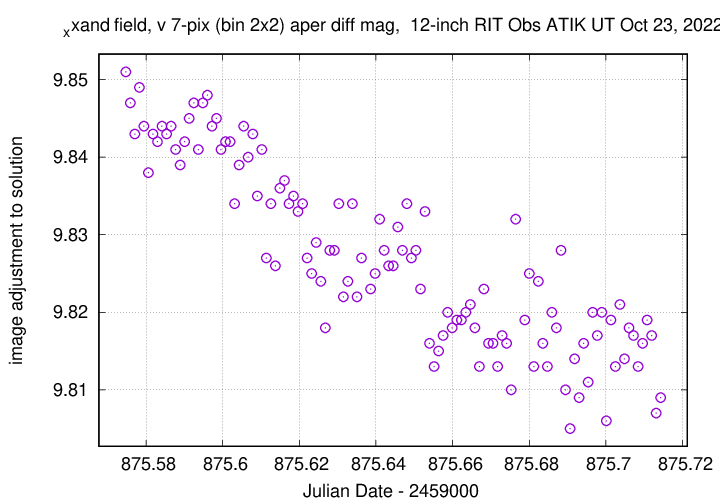
On the night of Oct 22/23, 2022, under very good conditions, I acquired images of
The astrometric measurements were made in the "traditional" manner, similar to that used for the many measurements in previous years:
The photometry of XX And was taken in the "B" and "V" filters, as usual. With this set of measurements, we have a complete coverage of the phase in these filters.
This is one of the stars that a capstone student may study over the next year in a project involving parallax. Ross 248 is a relatively faint red star surrounded by many other stars of similar brightness, so it's a good candidate for high-precision parallax measurements.
These observations involved:
The object is (currently) near position
RA = 23:41:55.27 Dec = +44:10:06.38 (J2000)
A chart of the field is shown below. The size of the chart is about 41 x 27 arcminutes. The noisy area at right (West) is the shadow of the guider's pickoff mirror.

I've marked the location of several comparison stars.
star UCAC4 B V r ------------------------------------------------------------------------- A UCAC4 671-120730 12.617 10.689 B UCAC4 671-120688 C UCAC4 671-120749 10.987 10.663 P kappa And 4.06 4.14 --------------------------------------------------------------------------
I took a photo of the finder TV's screen when pointing to Ross 248; this could be a useful reference for the future:

In order to get the best results for Ross 248, it is necessary to use only a subset of the stars in the camera's full field of view. I chose the "small" subset, which contain stars within 7 arcmin of the target, for this night.
Here are the positions I've measured so far. The most recent measurements are at bottom right.

Like Ross 248, GX And is a nearby (binary) star which will be the target of a parallax project in the coming year. One of the two components is bright -- about mag V = 8 -- so one must use short exposures to prevent it from saturating the detector. That may mean that this system isn't as easy to measure as Ross 248 or some others.
On this night, for GX And,
The object is currently close to this position:
RA = 00:18:28.4 Dec = +44:01:31 (J2000)
but it does have a very high proper motion.
A chart of the field is shown below. The size of the chart is about 41 x 27 arcminutes. The noisy area at right (West) is the shadow of the guider's pickoff mirror.

The two components of the GX And binary sit inside the box. I've marked the location of several comparison stars as well.
star UCAC4 B V r ----------------------------------------------------------- A 671-001473 9.939 9.790 B 670-001639 9.413 8.472 C 671-001509 12.712 11.421 11.001 -----------------------------------------------------------
I took a photo of the finder TV's screen when pointing to GX And; this could be a useful reference for the future:

Using the same techniques as described for earlier nights, I matched detected stellar positions to the Gaia DR2 catalog. I used all the stars in the field.
The target is moving to the upper-right with time, and clearly shows the back-and-forth motion due to parallax.

The star XX And is a variable star of the RR Lyr "AB" type. Its period may be changing slightly on long timescales -- that will be one focus of our study of it.
The main setup was:
Notes from the night:
The object is located at
RA = 01:17:27.41 Dec = +38:57:02.0 (J2000)
A chart of the field is shown below. The size of the chart is about 31 x 26 arcminutes.

I've marked the location of several comparison stars as well. You can find reference magnitudes for these stars at the AAVSO:
I'm not sure yet which reference star(s) might be best to shift the instrumental magnitudes to the standard scale. These might be good choices:
| Label | B | V |
| C = 111 | 11.575 | 11.101 |
| E = 117 | 12.503 | 11.745 |
I took a photo of the finder TV's screen when pointing to this target; this could be a useful reference for the future:

The sky value shows a nice, smooth curve, indicating no clouds.

The FWHM graph below shows no significant change over this short observing run.

Using aperture photometry with a radius of 7 pixels in V, 10 pixels in B (binned 2x2, each pixel is 1.24 arcsec, so a radii of 8.7 and 12.4 arcsec), I measured the instrumental magnitudes of a number of reference stars and the target. Following the procedures outlined by Kent Honeycutt's article on inhomogeneous ensemble photometry, I used all stars available in each image to define a reference frame, and measured each star against this frame.
Sigma-vs-mag plots show that the floor was about 0.005 mag in V, and 0.007 in B.

The change in zeropoint shows nothing other than a gradual decline as the field rose.

Photometry shows the star fading over this run.
